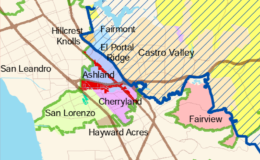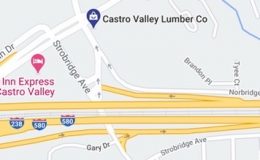Great article on this hot topic for the fate of the Daughtrey Building, Is there any way we can see the financial capacity analysis for each developer? BAU is rated at 38% and Alikian at 50%. I personally like to see a mixed use project in this site but am worried about the financial capacity of each developer, What if the project expenditure exceeds the budget then who will flip the bill for the completion of the project?
MAC expected to select preferred Daughtrey’s developer Monday night
- By : Michael Kusiak
- Category : Alameda County, Featured Story, Governance, MAC
- Tags: Daughtrey's Building, downtown castro valley, MAC, Municipal Advisory Council, Town Square


The Castro Valley Municipal Advisory Council (MAC) is expected to select a developer on Monday night for the long-stalled Daughtrey’s Building redevelopment.
At its June 1 meeting, public speakers spoke overwhelming in support of a mixed-used development proposed by Castro Valley resident Shawn Alikian. The MAC deadlocked when two motions, one that would have supported Alikian’s concept and one that would have supported Main Street Properties’ retail-only Alameda Marketplace food hall concept, failed to pass on tied votes of 3 to 3.
Since then, the Alameda County Board of Supervisors appointed Ted Riche to the council (bringing the MAC back to seven members), the Community Development Agency (CDA) has released the initial scoring of the proposals, and the three developer finalists have regularly engaged with the public at Tuesday night food trucks and at a Castro Valley Matters forum.
Process restarted
Last November, David Greensfelder, who was selected to develop the site in 2014, proposed a Lost Worlds “family entertainment center” as the sole occupant of the building. The MAC rejected his proposal, triggering a new process to find a developer. In March, the Alameda County Community Development Agency (CDA) issued a Request for Interest/Development Concept (RFI) that resulted in six development proposals.
A Selection Committee that included three MAC members (Marc Crawford, Sheila Cunha and Ken Carbone), CDA staff Eileen Dalton and Susan McCue, Sonia Urzua from Alameda County Planning, and Stuart Cook, Director of the County’s Surplus Property Authority picked three finalists among the six “responsive” proposals for further consideration.
Here are links to the three, top-rated proposals:
- Main Street Properties
Initial Proposal
Supplemental Interview Materials - Bay Area Urban
Initial Proposal
Supplemental Interview Materials - Alikian/Samson Properties
Initial Proposal
Supplemental Interview Materials
Selection Committee ranks proposals
Per the RFI, the proposals were evaluated using the following criteria:
- Development Team or business entities qualifications and financial capacity
- Meets the community’s desire for high-quality dining, food-related and retail experiences
- Transformative design and outstanding architecture
- Proven track record in completing development projects
- Project Timing – including milestones such as construction commencement and project completion
- Revenue generation – new property and sales tax revenues
Absent from last month’s meeting was detailed information on the scoring of the sites. Ahead of Monday’s meeting, CDA has released the Selection Committee detailed scoring of the proposals.
The Selection Committee ranked Main Street’s concept the highest. It received 97 percent of an available 120 points, and ranked highest or was tied among all other categories, except for “Architecture/Design,” where in ranked third behind Bay Area Urban and Alikian/Samson. Bay Area Urban’s overall score was 82 percent, and Alikian/Samson received a score of 68 percent. Unlike the failed Greensfelder proposal, all three of the proposals include multiple tenants.
The County hired an outside consultant to evaluate each developers “financial capacity to deliver a fully built-out project.” Bay Area Urban received the lowest financial capacity score at 38 percent. Alikian/Samson received a score of 50 percent, and Main Street received the highest score of 100 percent.
You can read a summary of each proposal in CVM’s previous post “Daughtrey’s proposals imagine transformed building with coffee, beer and housing.”
Residential proposals would require changes to shared parking agreement
Alikian/Samson and Bay Area Urban propose residential units to be included in their developments. At Febuary’s MAC meeting that considered the RFI and at Castro Valley Matter’s Daughtrey’s community visioning session in March, many community members spoke up in support of housing, a shift from previous community meetings over the past few years where the focus has been on commercial development or creating a town square at the site.
Residential use is not cited among the County’s list of expectations for a successful proposal in the RFI. Rather, the RFI states that a successful proposal would be “a development project with upscale, high-quality restaurant, food-related and retail uses offering new, unique choices,” and “a catalyst project that will attract new customers, shoppers and diners to downtown Castro Valley.”
The parking proposed by Bay Area Urban and Alikian/Samson would require an amendment to the shared parking agreement that governs the parking lot being built behind the Daughtrey’s and Ice Creamery buildings. The Alikian/Samson proposal would transform the basement into additional parking for building residents, but to do so would require removal of parking to access the basement parking, prompting the a need for the amendment. The Bay Area Urban proposal does not contemplate building additional parking for building residents and would require an amendment to the shared parking agreement to allow for overnight parking for residents.
 Dalton writes in a memo to the MAC:
Dalton writes in a memo to the MAC:
Because the Shared Parking Agreement did not anticipate residential units in the Daughtrey Building, residential (overnight) parking and/or removal of any spaces would require an amendment to the Shared Parking Agreement. The Bay Area Urban proposal would require overnight parking for its residential units, while the Alikian/Samson proposal would require the removal of parking spaces at the rear of the building in order to access the basement parking. To amend the Shared Parking Agreement, a developer would have to try to secure concurrence from the four property owners that are party to the Shared Parking Agreement.
Both Alikian/Samson and Bay Area Urban have indicated that they are working with the parties of the shared parking agreement to amend the agreement should be they be selected as the preferred developer.
Evolution of the Daughtrey’s site
In the heart of Castro Valley’s Downtown at 3295 Castro Valley Boulevard, the Daughtrey’s Building opened in November 1965 and was owned and operated continuously by Keller Daughtrey until summer 1991. The store closed at some point in the 1990s and was used intermittently for various businesses, including a billiards hall and a seasonal Halloween store.
The former Alameda County Redevelopment Agency paid $2.8 million for the building in 2011; it appraised at $950,000 in 2013. The on-going delay in the transfer and redevelopment of the building stems from the complexity of the redevelopment agency dissolution process. Prior to the decision to move ahead with seeking a commercial developer for the site, Castro Valley Matters advocated that Alameda County retain the site, demolish the building, and create a town square.
Resources
- Timeline of Castro Valley’s Daughtrey’s building
- Daughtrey’s proposals imagine transformed building with coffee, beer and housing
- Listen to the June 1, 2017 MAC meeting
The Castro Valley MAC meets Monday, July 17 at 6:00 pm at the Castro Valley Library at 3600 Norbridge Avenue. The MAC will also receive a update from the Alameda County Arts Commission about the community identifier mural for the Interstate 580 overpass at Redwood Road.



